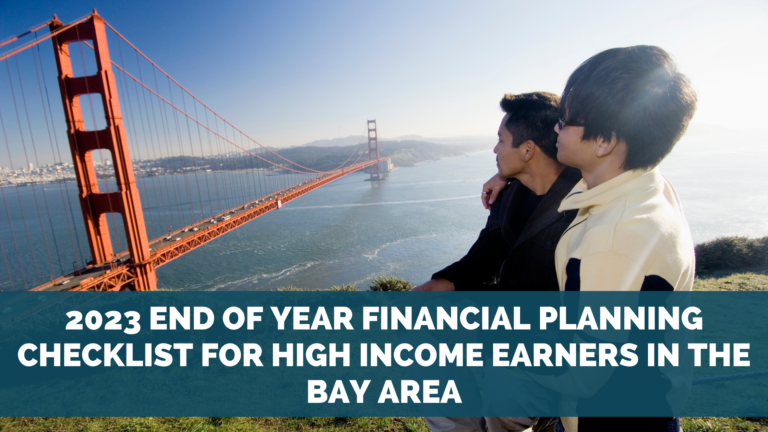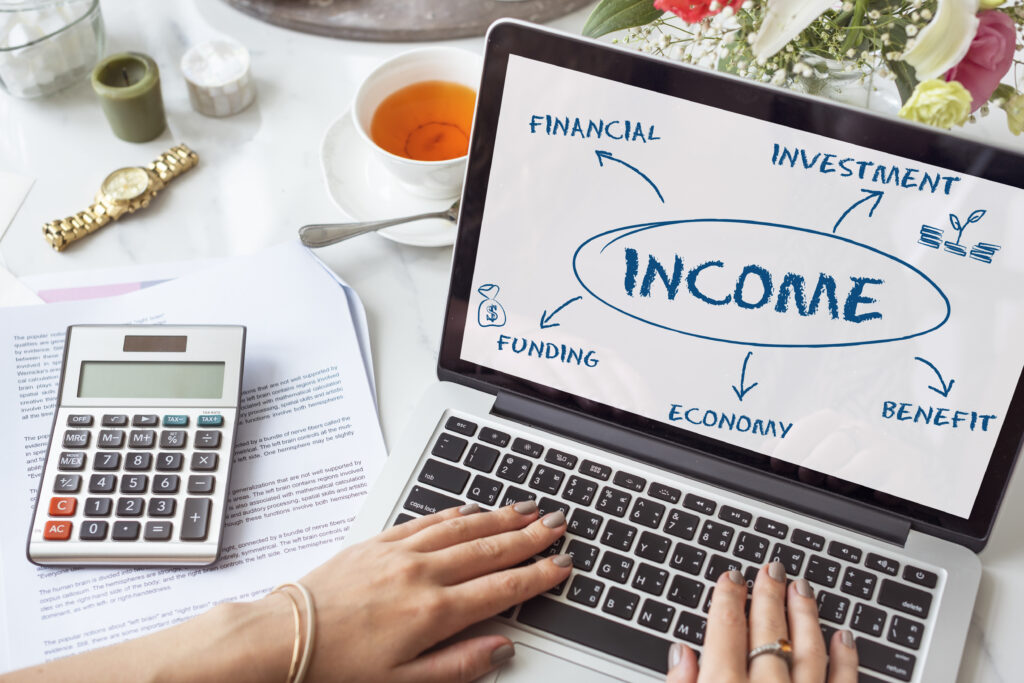
2023 End of Year Financial Planning Checklist for High Income Earners in the Bay Area
Living in expensive areas like San Francisco or Oakland can be tough. You might be scratching your head, wondering where all your money goes. Between California’s high tax rates and high cost of living, it’s easy to feel like no matter how much you earn it’s not quite enough.
If you’re ever felt trapped in the cycle of earning and spending, and you’re wondering “How do I ever get off this hamster wheel?”, now is the time to start getting serious about building the finances to support your best life.
To help you wrap up your year with confidence and set the stage for a prosperous new one, here’s a checklist that is tailored for women and LGBTQ professionals in the Bay Area who are serious about achieving the financial freedom to work and live on their terms.
Revisit your Cash Flow

- Figure our your yearly spending and savings rate. Where did your money go this year? This doesn’t have to be a painful exercise where you berate yourself for every line item in your credit card. To keep it easy, take a tops down approach and figure out how much you saved the past 12 months. If you’re saving less than 20% of your gross income, it’s worth doing a deeper dive. I believe that the biggest obstacle to financial freedom for a high income earner isn’t poor investment returns or taxes or inflation. It’s…drumroll…Lifestyle Creep. If you want the flexibility to work and live on your terms, you have to manage your spending. Aim for a savings rate of 30%+ if you’re really serious about getting off the hamster wheel.
- Max out your retirement contributions. Did you increase your contributions this year when the 401k limit went up to $22,500 per individual and $30,000 for those age 50 and older? As a high income earner, your combined Federal and California marginal tax rates may easily be over 40%. To keep more of your income, contribute as much as you can afford to a pre-tax retirement account. If you work for a state or local governmental agency or non-profit such as UCSF or Stanford, you may also have access to a 457b plan which doubles the amount you could sock away pre-tax.
- Does your employer offer after-tax 401k contributions? This doesn’t work for everyone, but if you’re still able to save more after maxing out your “regular” 401k and your employer offers this option (such as at big tech companies like Google and Amazon), you could contribute up to another $43.5K after-tax dollars into your 401k in 2023. These after-tax contributions can be rolled into a Roth IRA, which means you get tax-free growth and withdrawals in retirement. As a high income earner you would otherwise be disqualified from contributing to a Roth IRA, so this is a supercharged way to access this valuable tax shelter.
- Did you start a business, side gig, or consult this year? If so, you may qualify for a Solo 401k or SEP IRA. Solo 401ks can accept pre-tax or Roth savings, and they generally allow you to contribute more than a SEP. If you’re a W-2 earner who also does some freelance work, consider saving all of your side gig income into a Solo 401k and living off your salary. This will give a serious boost to your journey towards financial independence.
- Adjust your tax withholding and estimated payments. As the year winds down, it’s a good idea to consult with the IRS’s online withholding estimator or your financial or tax advisor to ensure everything is in line with your payroll withholding or anticipated payments. If you didn’t withhold enough throughout the year from your paycheck, you could be liable for an underpayment penalty. Most common reasons I see for underpayment is due to underwithholding on RSUs (for tech employees who receive stock compensation), not paying enough in estimated taxes (for self-employed folks), or having a large taxable capital gain.
- Reevaluate your short term cash storage. If you’re still saving your cash at an old school bank, you’re likely getting below market rates. Consider high yield savings accounts at online banks or money market funds. CDs are another option, though I suggest brokered CDs for better rates. If you’re holding excess cash beyond what’s needed for the next 1-2 years, consider investing. In my work as a financial planner, I’ve noticed that women have a bias toward hoarding cash. Remember that despite the higher returns you’re seeing, the real return on cash after inflation is zero.
- Order your credit report. Credit plays an important role in your financial life. You get a free credit report each year from the three credit reporting bureaus. Review the report for accuracy, open credit cards, loans, and credit inquiries. We all know someone who has been a victim of identity theft, so look for suspicious activity.
Tax Planning

- Embrace Tax loss harvesting. Do you have unrealized investment losses in your taxable accounts? If so, consider realizing losses to offset any gains. Once you make over $553,850 (MFJ, 2023), your long-term capital gains tax rate is 23.8%. Plus, you’ll get hit with California tax at 9.3%+ as there’s no preferential treatment for capital gains. So, tax loss harvesting can be very valuable during your high earning years. But remember – this ain’t a free lunch. At some point, these taxes will come due. So don’t just assume the more tax loss harvested the better. Have a strategy.
- Optimize your income and expenses. Tax planning is all about trying to realize taxable income at the lowest rates possible. If you are at the 35% bracket this year but expect to be in the 24% bracket next year because your spouse is taking some time off, can you push out your bonus into 2024? Could you wait to realize capital gains until next year? Are there any tax deductible expenses you can make now to reduce income?
- Open a Donor Advised Fund (DAF). If you are a consistent donor, giving can reduce your taxes even if you typically don’t itemize. When you contribute to a DAF, you get an immediate tax deduction. Those funds are invested and you can distribute them to qualified charities whenever you want. For example, if you typically give $5K per year to the Alameda County Food Bank or the National Center for Lesbian Rights , you might bunch 5 years worth of giving together to make a $25K contribution to a DAF. You get an immediate tax deduction on the $25K, and you can distribute that money over time.
- Choose how you fund charitable gifts wisely. It’s advantageous tax-wise to donate highly appreciated stock to a charity or donor-advised fund as opposed to selling positions and giving cash. If you are holding RSUs or shares purchased through ESPPs (employee stock purchase plans), donating appreciated shares can be a great way to give more while diversifying concentrated employee stock positions. Custodians have various deadlines for processing stock donations before the end of the year, so plan ahead.
- Consider a Roth conversion. This strategy is commonly used by retirees who are trying to realize their pre-tax IRA money at lower tax rates before their Social Security or RMDs kick in. But if you happen to find yourself in a low tax bracket like we did one year when we took a sabbatical to travel the world, you may consider a Roth conversion in order to convert pre-tax IRA money into a Roth for tax-free growth and withdrawals in the future.
Investments
- Rebalance your portfolio. You should review your asset allocation at least once a year and rebalance if necessary (though not much more than that, too frequent rebalancing can come at cost of higher tax and lower returns). If you’ve got a big chunk tied up in specific stocks and you want to diversify, consider selling and using the proceeds to rebalance.
- Tax-Efficient Portfolio Optimization: A regular investment account gets taxed differently than an IRA or 401K, which gets taxed differently than a Roth. Are you strategically placing investments in these different accounts to maximize tax efficiency?
- Mindful Investing: Reflect on your values and life goals, and ask whether your portfolio is aligned with these objectives. You can make social impacts with your investments while achieving your financial goals.When it comes to the implementation, the key factor is to allocate your impact investments in a way that keeps your portfolio aligned with your overall risk and reward objectives.
- Invest in Passion Projects: When it comes to funding your most important life goals, I believe in taking a risk managed globally diversified approach using tax-efficient and low-cost securities. However, if you can afford it and you enjoy the process, I encourage clients to consider allocating a small portion of their portfolio towards initiatives they’re passionate about. Examples include investing in an alternative energy fund, becoming an angel investor, or making a loan to your local bakery.
Healthcare
- Max out your health savings accounts (HSA) contributions. If you have a high deductible health plan and have access to an HSA, you can contribute up to up to $3850 for individuals and $7750 for families in 2023 (plus an additional $1000 if you are over 55). Health savings account offer a triple-tax advantage: deposits are tax-deductible, growth is tax-deferred, and spending is tax free. If you really want to optimize, consider using your HSA as a retirement account and pay for medical expenses out of pocket. You can take your HSA with you when you leave your employer. After age 65, you can use HSA funds for any purpose without penalties, the only catch being that you’ll pay ordinary income taxes on withdrawals not used for qualified medical expenses.
- Spend the money in your Flexible Savings Account (FSA). Don’t forget to spend funds in your FSA by December 31st or it may disappear depending on your company’s policy.
- Did you meet your health insurance plan’s annual deductible? If so, you may consider taking care of any additional medical needs before the end of the year when your deductible will reset.
- Review your employers open enrollment. Open enrollment typically runs through the end of the year and allows you to choose health coverage as well as other benefits, such as life insurance, disability insurance or legal assistance.
Consider your kids

- Consider 529 contributions. 529 accounts can now be used for private secondary school expenses in addition to college, adding more reason to fund an account for your child/children. If you don’t yet have children, you can also open 529s for yourself and change the beneficiary later. This maximizes the amount of time for tax-free compounding in the accounts.
- Open Roth IRA or Traditional IRA for your kids. Children’s IRA assets are non-assessable for student aid eligibility in the FASFA application. If your kids have jobs, urge them to contribute to a Roth IRA. $10K invested at 6% into a Roth IRA for a 16 year old would yield $173,775 in tax-free money when she’s 65. Consider matching their earning contributions to incentivize good financial behaviors. (Just remember that total contributions can’t exceed their total earned income.)
Beneficiaries and Liability

- Name your people. Has your household changed this year? Are the beneficiaries on your accounts current? Do you have a Health Care Directive? (You can use this free template for Californians) Do you have a financial power of attorney who could act on your behalf if you were disabled? (this free form follows the California regulations)
- Analyze your insurance policies. Make sure your home and auto coverage still matches your assets. If you’ve owned a home for a while in the Bay Area, it’s likely that the value has risen so much that you’re now under-insured. Evaluate if it’s time to add on earthquake insurance, umbrella insurance, disability insurance, life insurance, or long term care insurance.
Jennifer Dazols is an Oakland and San Francisco Bay Area based CERTIFIED FINANCIAL PLANNER™ who works with Women and LGBTQ tech-employed and self-employed professionals. You can schedule a free strategy session with her.


